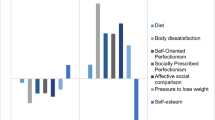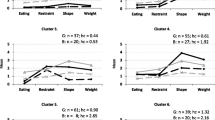Abstract
Despite the evidence that individuals with Asperger syndrome (AS) have a propensity for being underweight or having comorbid eating disorders, no previous research has compared the eating attitudes of adolescent girls with AS to typically developing peers. This study compared reports of eating problems provided by the adolescent girls themselves (56 with and 56 without AS) and their mothers on the EAT-26. Results indicated that adolescent girls with AS are at a higher risk for eating problems than their typically developing peers according to their reports and the reports of their mothers. Moreover, it was found that although the agreement between mothers’ and daughter’s reports is very satisfactory, mothers of girls with AS report statistically less eating-disordered behaviors than their daughters.
Similar content being viewed by others
References
Ahearn, W. H., Castine, T., Nault, K., & Green, G. (2001). An assessment of food acceptance or pervasive developmental disorder-not otherwise specified. Journal of Autism and Developmental Disorders, 31, 505–511. doi:10.1023/A:1012221026124.
American Psychiatric Association. (2000). Diagnostic and statistical manual of mental disorders (4th ed. rev). Washington, DC: American Psychiatric Association.
Asperger, H. (1944). Die “Autistichen Psychopathen” in Kindersalter. Archiv für Psychiatrie und Nervenkrankheiten, 117, 76–136. doi:10.1007/BF01837709.
Bolte, S., Ozkara, N., & Poustka, F. (2000). Autism spectrum disorders and low body weight: Is there really a systematic association? The International Journal of Eating Disorders, 31, 349–351. doi:10.1002/eat.10015.
Clark, J. H., Rhoden, D. K., & Turner, D. (1993). Symptomatic vitamin A and D deficiencies in an eight-year-old with autism. Journal of Parenteral and Enteral Nutrition, 17, 284–286. doi:10.1177/0148607193017003284.
Erdfelder, E., Faul, F., & Buchner, A. (2005). Power analysis for categorical methods. In B. S. Everitt & D. C. Howell (Eds.), Encyclopedia of statistics in behavioral science (pp. 1565–1570). Chichester, GB: Wiley.
Fisman, S., Steele, M., Short, J., Byrne, T., & Lavalee, C. (1996). Case study: Anorexia nervosa and autistic disorder in an adolescent girl. Journal of the American Academy of Child and Adolescent Psychiatry, 35, 937–940.
Garner, D. M., Olmsted, M. P., Bohr, Y., & Garfinkel, P. E. (1982). The eating attitudes test: Psychometric features and clinical correlates. Psychological Medicine, 12, 871–878.
Georgas, D. D., Paraskevopoulos, I. N., Bezevegis, I. G., & Giannitsas, N. D. (1997). Greek WISC-III: Wechsler intelligence scales for children. Athens: Ellinika Grammata.
Gillberg, I. C., Gillberg, C., Rastam, M., & Johnasson, M. (1996). The cognitive profile of anorexia nervosa: A comparative study including a community-based sample. Comprehensive Psychiatry, 37, 23–30. doi:10.1016/S0010-440X(96)90046-2.
Gillberg, I. C., Rastam, M., & Gillberg, C. (1995). Anorexia nervosa 6 years after onset: Part I personality disorders. Comprehensive Psychiatry, 36, 61–69. doi:10.1016/0010-440X(95)90100-A.
Happé, F. G. E. (1994). Annotation: Current psychological theories of autism: The ‘theory of mind’ account and rival theories. Journal of Child Psychology and Psychiatry and Allied Disciplines, 35, 215–229. doi:10.1111/j.1469-7610.1994.tb01159.x.
Hebebrand, J., Henninghausen, K., Nau, S., Himmelmann, G. W., Schulz, E., Schafer, H., et al. (1997). Low body weight in male children and adolescents with schizoid personality disorder or Asperger’s disorder. Acta Psychiatrica Scandinavica, 96, 64–67. doi:10.1111/j.1600-0447.1997.tb09906.x.
Ho, H. H., Eaves, L. C., & Peabody, D. (1997). Nutrient intake and obesity in children with autism. Focus on Autism and Other Developmental Disabilities, 12, 187–192.
Jacobi, C., Agras, W. S., Bryson, S., & Hamer, L. D. (2003). Behavioural validation, precursors and concomitants of picky eating in childhood. Journal of the American Academy of Child and Adolescent Psychiatry, 42, 76–84. doi:10.1097/00004583-200301000-00013.
Johnson, W. G., Grieve, F. G., Adams, C. D., & Sandy, J. (1999). Measuring binge eating in adolescents: Adolescent and parent versions of the questionnaire of eating and weight patterns. The International Journal of Eating Disorders, 26, 301–314. doi :10.1002/(SICI)1098-108X(199911)26:3<301::AID-EAT8>3.0.CO;2-M.
Kedeshy, J. H., & Budd, K. S. (1998). Childhood eating disorders: Biobehavioral assessment and intervention. Baltimore, MD: Paul Brookes Publishing Company.
Keen, D. (2007). Childhood autism, feeding problems and failure to thrive in early infancy: Seven case studies. European Child & Adolescent Psychiatry. doi:10.1007/s00787-007-0655-7.
Kerwin, M. L. (1999). Empirically validated treatments for feeding problems and failure to thrive. Journal of Pediatric Psychology, 24, 193–214. doi:10.1093/jpepsy/24.3.193.
Kerwin, M. L., Eicher, P. S., & Gelsinger, J. (2005). Parental report of eating problems and gastrointestinal symptoms in children with pervasive developmental disorders. Children’s Health Care, 34, 221–234. doi:10.1207/s15326888chc3403_4.
Kohn, M. T., & Golden, N. H. (2001). Eating disorders in children and adolescent: Epidemiology, diagnosis and treatment. Paediatric Drugs, 3, 91–99. doi:10.2165/00128072-200103020-00002.
Lord, C., Rutter, M., Goode, S., Heemsbergen, J., Jordan, H., Mawhood, L., et al. (1989). Autism diagnostic observation schedule: A standardized observation of communicative and social behavior. Journal of Autism and Developmental Disorders, 19, 185–212. doi:10.1007/BF02211841.
Lord, C., Rutter, M., & Le Couteur, A. (1994). Autism diagnostic interview-revised: A revised version of a diagnostic interview for caregivers of individuals with possible pervasive developmental disorders. Journal of Autism and Developmental Disorders, 24, 659–685. doi:10.1007/BF02172145.
Lukens, C. T., & Linscheid, T. R. (2008). Development and validation of an inventory to assess mealtime behavior problems in children with autism. Journal of Autism and Developmental Disorders, 38, 342–352. doi:10.1007/s10803-007-0401-5.
Lynch, W. C., Eppers, K. D., & Sherrodd, J. R. (2004). Eating attitudes of native American and white female adolescents: A comparison of BMI- and age-matched groups. Ethnicity & Health, 9, 253–266. doi:10.1080/1355785042000250094.
Lynch, W. C., Heil, D. P., Wagner, E., & Havens, M. D. (2007). Ethnic differences in BMI, weight concerns, and eating behaviors: Comparison of Native American, White, and Hispanic adolescents. Body Image, 4, 179–190. doi:10.1016/j.bodyim.2007.01.001.
Macht, J. (1990). Poor eaters: Helping children who refuse to eat. New York, NY: Plenum Press.
Mei, Z., Grummer-Strawn, L. M., Pietrobelli, A., Goulding, A., Goran, M. I., & Dietz, W. H. (2002). Validity of body mass index compared with other body-composition screening indexes for the assessment of body fatness in children and adolescents. The American Journal of Clinical Nutrition, 7, 585–597.
Mitchell, J. E., Cook-Myers, T., & Wonderlich, S. A. (2005). Diagnostic criteria for anorexia nervosa: Looking ahead to DSM-V. The International Journal of Eating Disorders, 37, 95–97. doi:10.1002/eat.20125.
Nilsson, E. W., Gillberg, C., Gillberg, I. C., & Rastam, M. (1999). Ten year follow-up of adolescent-onset anorexia nervosa: Personality disorders. Journal of the American Academy of Child and Adolescent Psychiatry, 38, 1389–1395. doi:10.1097/00004583-199911000-00013.
Rastam, M. (1992). Anorexia nervosa in 51 Swedish adolescents: Premorbid problems and comorbidity. Journal of the American Academy of Child and Adolescent Psychiatry, 31, 819–829.
Ritvo, E. M., & Freeman, B. J. (1978). National society for autistic children definition of the syndrome of autism. Journal of Autism and Childhood Schizophrenia, 8, 162–170. doi:10.1007/BF01537864.
Sancho, C., Arija, M. V., Asorey, O., & Canals, J. (2007). Epidemiology of eating disorders. European Child and Adolescent Psychiatry, 16, 495–504. doi:10.1007/s00787-007-0625-0.
Schreck, K. A., & Williams, K. (2006). Food preferences and factors influencing food selectivity for children with autism spectrum disorders. Research in Developmental Disabilities, 119, 783–790.
Schreck, K. A., Williams, K., & Smith, A. F. (2004). A comparison of eating behaviors between children with and without autism. Journal of Autism and Developmental Disorders, 34, 433–438. doi:10.1023/B:JADD.0000037419.78531.86.
Sobanski, E., Marcus, A., Henninghausen, K., Hebebrand, J., & Schmidt, M. H. (1999). Further evidence for a low body weight in male children and adolescents with Asperger’s disorder. European Child and Adolescent Psychiatry, 8, 312–314. doi:10.1007/s007870050106.
Steinberg, E., Tanofsky-Kraff, M., Cohen, M. L., Elberg, J., Freedman, R. J., Semega-Janneh, M., et al. (2004). Comparison of the child and parent forms of the questionnaire on eating and weight patterns in the assessment of children’s eating-disordered behaviors. The International Journal of Eating Disorders, 36, 183–194. doi:10.1002/eat.20022.
Tchanturia, K., Happé, F., Godley, J., Treasure, J., Bara-Carril, N., & Schmidt, U. (2004). ‘Theory of mind’ in anorexia nervosa. European Eating Disorders Review, 12, 361–366. doi:10.1002/erv.608.
Treasure, J. (2007). Is anorexia the female Asperger’s? Times (London, England), 18.
Vamvoukas, M. (1994). Aksiologisi anagnostikon ikanotiton [assessment of reading skills]. Athens: Grigoris.
Wakeling, A. (1996). Epidemiology of anorexia nervosa. Psychiatry Research, 62, 3–9. doi:10.1016/0165-1781(96)02983-6.
Ward, A., Ramsey, R., Turnbull, S., Steele, M., Steele, H., & Treasure, J. (2001). Attachment in anorexia nervosa: A transgenerational perspective. The British Journal of Medical Psychology, 74, 497–505. doi:10.1348/000711201161145.
Whiteley, P., Rodgers, J., & Shattock, P. (2000). MMR and autism. Autism, 4, 207–211. doi:10.1177/1362361300004002008.
Williams, P. G., Darlymple, N., & Neal, J. (2000). Eating habits of children with autism. Pediatric Nursing, 26, 259–264.
Woolston, J. L. (1991). Eating and growth disorders in infants and children. Newbury Park, CA: Sage Publications.
Zucker, N. L., Losh, M., Bulik, C. M., LaBar, K. S., Piven, J., & Pelphrey, K. A. (2007). Anorexia nervosa and autism spectrum disorders: Guided investigation of social cognitive endophenotypes. Psychological Bulletin, 133, 976–1006. doi:10.1037/0033-2909.133.6.976.
Acknowledgements
The author would like to thank the participants of this study and the following professionals for their help and support: Ioannis Agaliotis, Christos Alexiou, Eleni Alyfanti, Dimosthenis Andriopoulos, Dimitrios Axiotis, Anastasia Christofilopoulou, Antonia Dionysopoulou, Ourania Founta, Angeliki Gena, Maria Georgiadi, Theodoros Gerontas, Efthalia Kaderoglou, Maria Kapetanaki, Athanasios Kousthenis, Antonios Katsoulas, Athena Matsouka, George Kolyvas, Georgia Loggou, Evangelia Magoula, Dimitris Matthaios, Eva Mourelatou, Vagia Papageorgiou, Katerina Papathanasiou, Elias Petalas, Filippos Stefanidis, Maria Tarpani, Georgia Theohari, Spyridon Trikoss, Vlastaris Tsakiris, Nikolaos Tsibiskakis, Marina Tsontaki, Katerina Vagena, Assimina Vatsistsi, Dimitra Vgontza.
Author information
Authors and Affiliations
Corresponding author
Rights and permissions
About this article
Cite this article
Kalyva, E. Comparison of Eating Attitudes between Adolescent Girls with and without Asperger Syndrome: Daughters’ and Mothers’ Reports. J Autism Dev Disord 39, 480–486 (2009). https://doi.org/10.1007/s10803-008-0648-5
Received:
Accepted:
Published:
Issue Date:
DOI: https://doi.org/10.1007/s10803-008-0648-5




